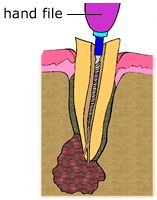|
Introduction
Retreatment is necessary when bacteria have re-entered the tooth. This is usually due to decay or untreated canal areas. The patient may experience swelling or pain in chewing.
Sometimes a patient may have no symptoms, but their x-ray shows that there is a problem with a tooth that has previously undergone root canal therapy.

What Happens During Root Canal Retreatment?
Step one:
After the tooth is "numbed", the canal system will be reopened to remove the previous root canal material. This may involve removing a crown, post and core material. Sometimes we are able to make a small hole in the existing restoration and work through that opening. The canals are then thoroughly cleansed and shaped along their entire length.

Step two:
The canals are refilled with gutta-percha and the opening is sealed with a sterile cotton pellet and a temporary filling.

Step three:
The tooth is restored within a couple of weeks. If your existing crown can be saved, then you will need to have it repaired. If you do not have a crown, it will probably be recommended.
With time, the bone will heal where the bacteria was removed.

What you should know following treatmentFollowing Root Canal Therapy or
Root Canal Retreatment:
- The treated tooth is commonly VERY tender to touch, biting, tapping or chewing for a few days after treatment. DO NOT CHEW ON THAT SIDE.
- Discomfort usually subsides in a couple of days, but may last as long as a few weeks. Improvement will be gradual.
- The treated tooth, the injection sites, as well as the soft tissues around the tooth, will feel sore and tender.
- If your tooth throbs, keep your head elevated, even when lying down. Refrain from any strenuous activity.
- We usually recommend a non-steroidal anti-inflammatory medication such as ibuprofen, Advil, Motrin, or aspirin for at least three to five days following treatment. If you cannot take any anti-inflammatory medication, then take extra-strength Tylenol. If any of the recommended painkillers are not effective relieving the pain, you should call the office.
- Take all prescribed medication as directed.
- Rinsing the mouth with warm salt water (one teaspoon salt to 8 oz. of warm water), three to four times a day may also be helpful in relieving discomfort.
- If you initially feel better, but then get significantly worse two or three days after treatment, you may be experiencing what is known as a "flare-up." This is not a common occurrence, but if it happens, please contact our office.
- There is usually no necessary "waiting period" to restore endodontically treated teeth, unless otherwise indicated. Have the tooth restored as soon as possible. Do not wait more than two to four weeks.
- We routinely like to perform a follow-up exam at least six months after the treatment. We want to evaluate the treatment outcome, be sure that you have regained normal function with the tooth, and determine the presence of bone healing. There is no charge for this visit.
|





